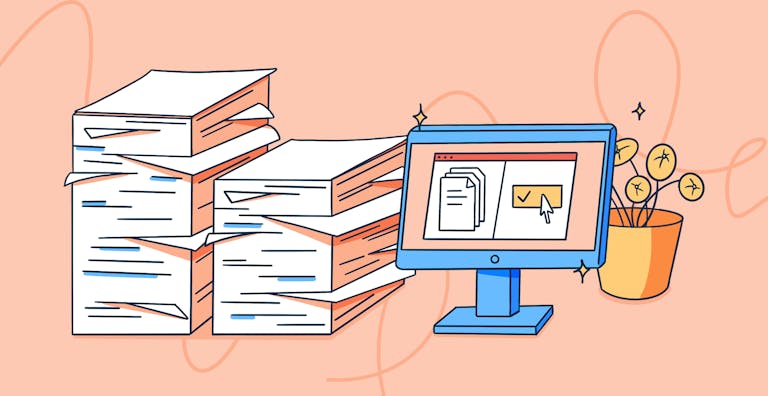The terms "digitisation" and "digitalisation" are frequently used interchangeably in business discussions, yet they represent fundamentally different concepts with distinct implications for your organisation's technology strategy. Understanding this distinction is crucial for UK businesses navigating the evolving digital landscape, particularly as government initiatives like Made Smarter and the Technology Adoption Review 2025 continue to support enterprise-wide technology adoption.
This comprehensive guide clarifies the definitions, explores practical applications, and explains why recognising the difference between digitisation and digitalisation can transform how your business approaches digital investment and implementation. Whether you're converting analog data to digital formats or leveraging digital technologies to reimagine entire business processes, this article provides the framework for strategic decision-making.
Brief Summary:
- Digitisation defined: The technical process of converting analog data to digital formats—transforming paper documents, physical records, and analog media into PDFs, databases, and digital files that computers can process
- Digitalisation defined: The strategic transformation of business processes and operations using digital technologies to create new value, improve efficiency, and enable data-driven insights
- Key distinction: Digitisation converts format; digitalisation transforms workflows, business models, and customer experiences
- Business impact: Understanding the difference between digitization and digitalization enables better technology investment decisions, more effective resource allocation, and measurable competitive advantages
- Implementation approach: Successful organisations leverage digitisation as a foundation for broader digitalisation initiatives, creating pathways to comprehensive digital transformation
What Is Digitisation?
Digitisation refers to the technical process of converting information from analogue or physical formats into digital representations. At its most fundamental level, digitisation transforms continuous physical signals—such as printed text, photographs, or audio recordings—into discrete binary data that computers can process and store.
The Core Process of Converting Analogue to Digital
The digitisation process involves capturing physical information and encoding it as sequences of ones and zeros. According to Gartner's IT Glossary, digitisation is "the process of changing from analog to digital form, also known as digital enablement."
This technical conversion creates digital artefacts from physical sources but doesn't inherently change how organisations use the information. A scanned PDF of a contract remains functionally similar to its paper predecessor—it's simply stored and transmitted differently. The digital format provides accessibility and durability advantages, but the underlying business process remains unchanged.
The distinction matters because many UK businesses invest significantly in converting analog data without realising they're addressing only the first step of a much larger opportunity.
Real-World Examples of Digitisation
Common digitisation activities in UK businesses include:
- Document scanning: Converting paper contracts, invoices, and records into PDF or image files for digital storage
- Audio digitisation: Transforming vinyl records, cassette tapes, or meeting recordings into MP3 or WAV files
- Photograph conversion: Scanning physical photographs into JPEG or PNG formats for digital archives
- Form digitisation: Creating digital versions of paper forms that can be completed on-screen
- Archival preservation: Converting historical records, microfilm, or microfiche into searchable digital databases
- Medical records: Scanning patient files into electronic health record systems
Whilst digitisation provides tangible benefits—reduced physical storage requirements, improved accessibility, easier duplication, and better disaster recovery—it represents only the initial step toward comprehensive digital maturity.
Good to know:
When beginning your digitisation journey, prioritise high-value documents first—contracts, invoices, and compliance records. These typically deliver the quickest ROI through reduced storage costs and improved accessibility. Once digitised, these documents become the foundation for broader digitalisation initiatives like automated approval workflows.
What Is Digitalisation?
Digitalisation extends far beyond simple format conversion. It represents the fundamental reimagining of business processes, workflows, and customer interactions through strategic technology adoption. Where digitisation asks "how do we convert this to digital?", digitalisation asks "how can digital technologies improve how we work?"
Transforming Business Processes Through Technology
According to Eurofound's research for the European Commission, "Digitalisation is the ongoing integration of digital technologies and digitised data across the economy and society." This definition emphasises that digitalisation involves not just tools, but fundamental changes to how work gets done.
Digitalisation changes the nature of business operations themselves. Rather than simply storing a contract digitally, digitalisation might involve implementing an electronic signature platform that eliminates printing, posting, and manual filing entirely—transforming the entire contract workflow from a multi-day manual process to a matter of minutes.
A practical example of digitalisation in contract management is the adoption of electronic signature platforms. Rather than printing contracts, posting them for wet signatures, and manually filing the originals, organisations using Yousign's electronic signature solution transform the entire workflow. The process moves from days or weeks to minutes, with automatic routing, real-time status tracking, and secure digital storage—eliminating paper whilst creating comprehensive audit trails that meet UK and EU legal requirements.
Practical Applications of Digitalisation
UK organisations implementing digitalisation initiatives typically focus on:
- Workflow automation: Implementing digital approval processes that route documents automatically based on business rules, eliminating manual handoffs and reducing turnaround time
- Customer interaction transformation: Replacing in-person meetings with video conferencing platforms that integrate calendar scheduling, document sharing, and electronic signature capabilities
- Data-driven decision-making: Deploying business intelligence tools that analyse operational data in real-time, enabling evidence-based strategic decisions and predictive analytics
- Communication digitalisation: Adopting platforms like Microsoft Teams or Slack that replace email chains and in-person meetings with structured, searchable digital channels
- Process integration: Connecting previously separate systems—such as CRM, ERP, accounting, and project management tools—to create seamless information flow
- IoT implementation: Deploying Internet of Things sensors to gather real-time data from physical assets, enabling predictive maintenance and operational optimisation
The UK Government's Technology Adoption Review 2025 demonstrates that organisations pursuing comprehensive digitalisation strategies achieve measurably superior business outcomes, including higher revenue growth, improved operational efficiency, and enhanced customer satisfaction.
Key Differences Between Digitisation and Digitalisation
Understanding the distinction between these concepts enables more effective technology strategy:
Aspect | Digitisation | Digitalisation |
|---|---|---|
Primary focus | Converting format | Transforming processes |
Scope | Information and data | Workflows and business models |
Complexity | Technical conversion | Strategic implementation |
Outcome | Digital copies of analogue assets | New ways of working and value creation |
Investment level | Moderate (scanning equipment, storage) | Substantial (platforms, change management, training) |
Example | Scanning a paper invoice | Implementing automated invoice processing with approval workflows and data extraction |
Whilst digitisation provides the raw materials—digital information—digitalisation leverages those materials to fundamentally change how organisations operate. Industry analysts consistently observe that digitisation without strategic digitalisation merely creates digital versions of inefficient processes—faster filing of unnecessary paperwork rather than workflow transformation.
The Role of Digital Transformation
Moving Beyond Digitisation and Digitalisation
Digital transformation represents the most comprehensive level of organisational change, encompassing both digitisation and digitalisation whilst extending to business model innovation, cultural shifts, and customer experience reimagination.
The UK Government's Technology Adoption Review indicates that digital transformation involves rethinking entire value propositions, not merely improving existing operations. Organisations pursuing true transformation might pivot from product-centric to service-centric models, develop entirely new revenue streams, or fundamentally restructure how they deliver value to customers.
Advanced digital transformation initiatives increasingly incorporate artificial intelligence and machine learning capabilities, enabling predictive analytics, automated decision making, and personalised customer experiences that were impossible with traditional digitisation alone. These technologies analyse vast amounts of data to identify patterns, optimise processes, and create competitive advantages.
For UK SMEs, this progression typically follows a maturity curve: initial digitisation efforts (document scanning, cloud storage adoption) provide foundations for digitalisation initiatives (workflow automation, integrated systems), which ultimately enable transformational changes (new business models, platform-based services, data-driven innovation).
Why Understanding the Distinction Matters for UK Businesses
Strategic Decision-Making
Clarity about digitisation versus digitalisation informs more effective technology investment decisions. Organisations that confuse the two concepts often over-invest in format conversion (digitisation) whilst neglecting the process transformation (digitalisation) that delivers measurable business value.
When evaluating technology initiatives, UK business leaders should ask: "Are we simply creating digital versions of existing processes, or are we fundamentally improving how work happens?" This distinction determines whether investments yield marginal efficiency gains or transformational competitive advantages.
Resource Allocation and ROI
Digitisation projects typically require moderate investment with predictable, incremental returns—reduced storage costs, easier information sharing, and improved disaster recovery capabilities. These projects often pay for themselves through operational cost reduction within 12-18 months.
Digitalisation initiatives demand more substantial investment in technology, change management, and organisational capability development. However, they deliver exponentially greater returns through productivity improvements, enhanced customer experiences, new revenue opportunities, and competitive differentiation.
Understanding this distinction prevents the common pitfall of expecting transformational results from digitisation-level investments.
Success Stories: How UK Businesses Benefit from Understanding the Distinction
Digitalisation Across Industries
Different sectors leverage the digitisation-to-digitalisation progression in unique ways:
- Manufacturing: A UK manufacturer might begin by digitising equipment manuals and maintenance logs (digitisation), then implement an ERP system integrating production scheduling, inventory management, and quality control (digitalisation). Advanced manufacturers add IoT sensors to production lines, enabling real-time monitoring and predictive maintenance (digital transformation).
- Legal Services: Law firms typically start by scanning case files and contracts into digital archives (digitisation). Progressive firms then adopt case management platforms with automated document assembly, electronic signature workflows, and client portals (digitalisation). Leading firms integrate artificial intelligence for contract review and legal research (digital transformation).
- Healthcare: NHS trusts digitise patient records by scanning paper files (digitisation), then implement integrated electronic health record systems that enable real-time information sharing across departments (digitalisation). Advanced trusts deploy telemedicine platforms and AI-powered diagnostic tools (digital transformation).
- Retail: Retailers digitise product catalogues and customer records (digitisation), then implement e-commerce platforms with inventory synchronisation and customer relationship management (digitalisation). Market leaders add personalised recommendation engines and omnichannel experiences (digital transformation).
These examples demonstrate how understanding the distinction enables staged, strategic technology adoption aligned with business objectives and resource availability.
Implementing Both Strategies in Your Organisation
Starting Your Digitisation Journey
UK businesses beginning digital adoption should prioritise:
- Document inventory: Identify high-value paper-based information requiring conversion
- Format standardisation: Establish consistent file formats and naming conventions
- Quality assurance: Implement verification processes ensuring digitised information remains accurate and complete
- Secure storage: Deploy appropriate cloud or server infrastructure with proper access controls and backup procedures
- Metadata strategy: Create searchable tags and categories that make digitised information readily discoverable
These foundational digitisation efforts create the information infrastructure necessary for subsequent digitalisation initiatives.
Building a Digitalisation Roadmap
Effective digitalisation requires strategic planning:
- Process mapping: Document current workflows identifying inefficiencies, bottlenecks, and manual handoffs
- Pain point prioritisation: Focus initial efforts on processes causing the greatest operational friction
- Technology evaluation: Research platforms and tools specifically designed to address identified pain points
- Stakeholder engagement: Involve employees who will use new systems throughout selection and implementation
- Phased implementation: Deploy changes incrementally, allowing time for adoption and refinement before expanding scope
- Continuous improvement: Establish feedback mechanisms and metrics tracking efficiency gains
Government programmes like Made Smarter offer subsidised consultancy helping UK manufacturers develop comprehensive digitalisation roadmaps aligned with industry best practices. The SME Digital Adoption Taskforce provides additional resources for small and medium-sized enterprises pursuing digital transformation strategies.
Transform Your Contract Workflows
Eliminate printing, posting, and manual filing whilst ensuring full legal compliance

Common Misconceptions and Pitfalls
Misconception 1: "Digitisation automatically delivers productivity gains"
Reality: Simply converting paper to PDF doesn't improve workflows. You've merely shifted inefficiency from physical to digital form. Without accompanying process redesign, digitised documents may actually create new problems—such as poorly organised digital filing systems that are harder to navigate than physical archives.
Important:
Digitising inefficient processes simply creates digital inefficiency. Before scanning thousands of paper forms, ask: 'Should this process exist at all?' Many organisations discover that digitalisation enables them to eliminate entire workflows rather than merely converting them to digital formats.
Misconception 2: "Digitalisation requires replacing all existing systems simultaneously"
Reality: Incremental adoption—starting with high-impact processes—typically proves more successful than wholesale replacement. Phased implementation allows organisations to learn, adapt, and build internal capability whilst managing risk.
Misconception 3: "Technology alone drives digitalisation success"
Reality: Cultural change, employee training, and leadership commitment matter as much as technology selection. Research by the UK Government's Technology Adoption Review found that organisations with strong change management practices achieved 3x higher success rates in digitalisation initiatives.
Misconception 4: "Small businesses don't need to distinguish between digitisation and digitalisation"
Reality: Resource-constrained SMEs particularly benefit from understanding this distinction, ensuring limited budgets address root causes rather than symptoms. Focusing scarce resources on high-impact digitalisation projects delivers greater returns than comprehensive digitisation efforts.
Misconception 5: "Digitalisation eliminates the need for digitisation"
Reality: The two strategies are complementary, not competing. Digitalisation often requires digitised information as input. However, strategic organisations digitise selectively—only the information needed for priority processes—rather than digitising everything before pursuing digitalisation.
Frequently Asked Questions
Can my organisation pursue digitisation and digitalisation simultaneously?
Yes, and many successful organisations do. Digitisation often creates immediate value whilst laying groundwork for broader digitalisation initiatives. The key is maintaining clear objectives for each activity rather than conflating them. Start with a pilot process that requires both: digitise the necessary documents, then redesign the workflow using digital technologies.
How long does digitalisation typically take for UK SMEs?
Government research suggests 12-18 months for meaningful transformation, though quick wins often emerge within 3-6 months. Timeline depends on organisational complexity, chosen technology, and change management effectiveness. Simple workflow automation projects may deliver results in weeks, whilst comprehensive ERP implementations may require 18-24 months.
What percentage of revenue should UK SMEs allocate to digitisation and digitalisation?
Industry benchmarks suggest 4-6% of annual revenue for technology initiatives, with 5% being most common among digitally mature SMEs. However, allocation should reflect strategic priorities: organisations pursuing aggressive digital transformation may invest 8-10%, whilst those in maintenance mode may invest 2-3%.
Do we need external consultants for digitalisation, or can we manage internally?
Whilst internal teams often successfully lead digitisation efforts, digitalisation initiatives frequently benefit from external expertise—particularly for process redesign and technology selection. Government programmes like Made Smarter provide subsidised consultancy specifically for this purpose, reducing cost barriers for SMEs.
How do we measure ROI from digitalisation initiatives?
Track metrics including process completion time, error rates, customer satisfaction scores, employee productivity, and cost per transaction. Establish baselines before implementation to demonstrate improvement quantitatively. Advanced organisations also measure strategic benefits like market responsiveness, innovation velocity, and competitive positioning.
What's the first step: digitisation or digitalisation?
Most organisations benefit from targeted digitisation—converting key information to digital formats—before pursuing comprehensive digitalisation. However, avoid digitising everything before starting process transformation, as some workflows may be eliminated entirely through digitalisation. Begin with a single high-impact process, digitise only what's necessary, then redesign the workflow using digital technologies. This approach delivers faster results and builds internal capability.
Conclusion
The distinction between digitisation and digitalisation, whilst seemingly semantic, carries profound implications for UK businesses navigating digital adoption. Digitisation—converting analog data to digital formats—provides essential infrastructure but delivers limited competitive advantage on its own. Digitalisation—transforming business processes through strategic technology use—creates measurable value through efficiency gains, enhanced customer experiences, and new capabilities.
Successful UK organisations recognise both concepts as complementary rather than competing priorities. They pursue targeted digitisation creating digital assets whilst simultaneously implementing digitalisation initiatives that fundamentally improve how work happens. By leveraging digital technologies strategically, these businesses position themselves for long-term competitiveness in an increasingly digital economy.
As government support programmes continue expanding access to digital technologies and expertise, UK businesses of all sizes can leverage this understanding to make more informed investment decisions, allocate resources effectively, and ultimately achieve the transformational results that digital adoption promises.
Your digital transformation journey begins with clarity about objectives: are you converting formats, or transforming how your organisation creates value? The answer determines whether technology investments yield marginal improvements or competitive transformation. Understanding the difference between digitization and digitalization empowers you to chart the right course for your business.
Transform your document workflows
Start your free 14-day trial today








